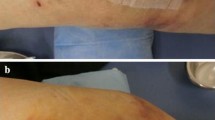Abstract
Introduction
The goals of this study were to compare patient satisfaction and wound-related complications in patients receiving 2-octyl cyanoacrylate (glue) and polyester mesh for skin closure after primary total knee arthroplasty (TKA) versus staples.
Methods
A total of 60 knees in 54 patients undergoing TKA were enrolled in a prospective trial and randomized to receive either skin closure with glue and polyester mesh (n = 30) or a control group closed with staples (n = 30). Hollander wound cosmesis score (measured on a scale of 0–5, with 0 being the best) and visual analog scale (VAS) scores (range 0–100 mm) for patient satisfaction with wound cosmesis, as well as wound-related readmission, reoperation, and complications, including superficial surgical site infection, wound dehiscence, wound hematoma, stitch abscess, and wound discharge, were assessed at 6 weeks and 90 days after TKA. Baseline characteristics were not statistically significantly different between the groups (p > 0.05).
Results
At 6 weeks and 90 days, the Hollander wound cosmesis score was significantly lower (p < 0.01) in the glue and polyester mesh groups. Similarly, at 6 weeks and 90 days, the VAS for patient satisfaction with wound cosmesis was significantly higher (p < 0.01) in the glue and polyester mesh groups. The rate of superficial surgical site infection was 1/30 (3%) in glue and polyester mesh groups versus zero in the control group (p = 1.00). The rate of wound dehiscence was 1/30 (3%) in glue and polyester mesh groups versus zero in the control group (p = 1.00).
Conclusion
These results suggest that glue and polyester mesh closure may offer superior cosmetic outcomes to staples for skin closure in TKA.

Similar content being viewed by others
Change history
31 March 2020
The original version of this article unfortunately contained a mistake.
References
Kurtz S, Ong K, Lau E et al (2007) Projections of primary and revision hip and knee arthroplasty in the United States from 2005 to 2030. J Bone Joint Surg Ser A 89:780–785. https://doi.org/10.2106/JBJS.F.00222
Khurana A, Parker S, Goel V, Alderman PM (2008) Dermabond wound closure in primary hip arthroplasty. Acta Orthop Belg 74:349–353
Luzzi AJ, Fleischman AN, Matthews CN et al (2018) The “bundle busters”: incidence and costs of postacute complications following total joint arthroplasty. J Arthroplasty 33:2734–2739. https://doi.org/10.1016/j.arth.2018.05.015
Kurtz SM, Lau EC, Ong KL et al (2017) Which clinical and patient factors influence the national economic burden of hospital readmissions after total joint arthroplasty? Clin Orthop Relat Res 475:2926–2937. https://doi.org/10.1007/s11999-017-5244-6
Bozic KJ, Ward L, Vail TP, Maze M (2014) Bundled payments in total joint arthroplasty: targeting opportunities for quality improvement and cost reduction. Clin Orthop Relat Res 472:188–193. https://doi.org/10.1007/s11999-013-3034-3
Kim K, Iorio R (2017) The 5 clinical pillars of value for total joint arthroplasty in a bundled payment paradigm. J Arthroplasty 32:1712–1716. https://doi.org/10.1016/j.arth.2017.02.012
Kremers K, Leijtens B, Camps S et al (2019) Evaluation of early wound leakage as a risk factor for prosthetic joint infection. J Am Assoc Nurse Pract 31:337–343. https://doi.org/10.1097/JXX.0000000000000159
El-Gazzar Y, Smith DC, Kim SJ et al (2013) The use of dermabond(R) as an adjunct to wound closure after total knee arthroplasty: examining immediate post-operative wound drainage. J Arthroplasty 28:553–556. https://doi.org/10.1016/j.arth.2012.07.038
Siddiqui M, Bidaye A, Baird E et al (2016) Wound dressing following primary total hip arthroplasty: a prospective randomised controlled trial. J Wound Care 25(40):42–45. https://doi.org/10.12968/jowc.2016.25.1.40
Sutton N, Schmitz N-D, Johnston SS (2018) Economic and clinical comparison of 2-octyl cyanoacrylate/polymer mesh tape with skin staples in total knee replacement. J Wound Care 27:S12–S22. https://doi.org/10.12968/jowc.2018.27.Sup4.S12
Almustafa MA, Ewen AM, Deakin AH et al (2018) Risk factors for surgical site infection following lower limb arthroplasty: a retrospective cohort analysis of 3932 lower limb arthroplasty procedures in a high volume arthroplasty unit. J Arthroplasty 33:1861–1867. https://doi.org/10.1016/j.arth.2018.01.037
Holte AJ, Tofte JN, Dahlberg GJ, Noiseux N (2017) Use of 2-octyl cyanoacrylate adhesive and polyester mesh for wound closure in primary knee arthroplasty. Orthopedics 40:e784–e787. https://doi.org/10.3928/01477447-20170531-03
Kondrup JD, Qayyum AM (2018) Closing the gap: novel abdominal wound closure techniques. Surg Technol Int 32:25–31
Lee JC, Ishtihar S, Means JJ et al (2018) In search of an ideal closure method: a randomized, controlled trial of octyl-2-cyanoacrylate and adhesive mesh versus subcuticular suture in reduction mammaplasty. Plast Reconstr Surg 142:850–856. https://doi.org/10.1097/PRS.0000000000004726
Richter D, Stoff A, Ramakrishnan V et al (2012) A comparison of a new skin closure device and intradermal sutures in the closure of full-thickness surgical incisions. Plast Reconstr Surg 130:843–850. https://doi.org/10.1097/PRS.0b013e318262f237
Singer AJ, Thode HCJ, Hollander JE (2000) Research fundamentals: selection and development of clinical outcome measures. Acad Emerg Med 7:397–401
Healy WL, Della Valle CJ, Iorio R et al (2013) Complications of total knee arthroplasty: standardized list and definitions of the knee society knee. Clin Orthop Relat Res 471:215–220. https://doi.org/10.1007/s11999-012-2489-y
Deirmengian C, Kardos K, Kilmartin P et al (2014) Diagnosing periprosthetic joint infection: has the era of the biomarker arrived? Clin Orthop Relat Res 472:3254–3262
Khan RJK, Fick D, Yao F et al (2006) A comparison of three methods of wound closure following arthroplasty: a prospective, randomised, controlled trial. J Bone Joint Surg Br 88:238–242. https://doi.org/10.1302/0301-620X.88B2.16923
Miller AG, Swank ML (2010) Dermabond efficacy in total joint arthroplasty wounds. Am J Orthop (Belle Mead NJ) 39:476–478
Acknowledgements
Funding was provided by Ethicon (Grant No. 15-206).
Author information
Authors and Affiliations
Corresponding author
Additional information
Publisher's Note
Springer Nature remains neutral with regard to jurisdictional claims in published maps and institutional affiliations.
Rights and permissions
About this article
Cite this article
Sundaram, K., Piuzzi, N.S., Patterson, B.M. et al. Skin closure with 2-octyl cyanoacrylate and polyester mesh after primary total knee arthroplasty offers superior cosmetic outcomes and patient satisfaction compared to staples: a prospective trial. Eur J Orthop Surg Traumatol 30, 447–453 (2020). https://doi.org/10.1007/s00590-019-02591-4
Received:
Accepted:
Published:
Issue Date:
DOI: https://doi.org/10.1007/s00590-019-02591-4




